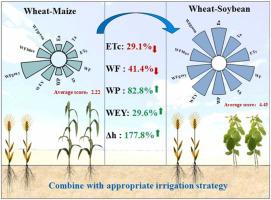当前位置:
X-MOL 学术
›
Field Crops Res.
›
论文详情
Our official English website, www.x-mol.net, welcomes your feedback! (Note: you will need to create a separate account there.)
Enhancing productivity while reducing water footprint and groundwater depletion: Optimizing irrigation strategies in a wheat-soybean planting system
Field Crops Research ( IF 5.8 ) Pub Date : 2024-03-08 , DOI: 10.1016/j.fcr.2024.109331 Pengnian Wu , Yanli Wang , Jing Shao , Haolin Yu , Zhiheng Zhao , Lingyun Li , Peimeng Gao , Yuming Li , Shuimiao Liu , Chenkai Gao , Xiaokang Guan , Pengfei Wen , Tongchao Wang
Field Crops Research ( IF 5.8 ) Pub Date : 2024-03-08 , DOI: 10.1016/j.fcr.2024.109331 Pengnian Wu , Yanli Wang , Jing Shao , Haolin Yu , Zhiheng Zhao , Lingyun Li , Peimeng Gao , Yuming Li , Shuimiao Liu , Chenkai Gao , Xiaokang Guan , Pengfei Wen , Tongchao Wang

|
Traditional agricultural practices in the Huang-Huai-Hai Plain have led to a decrease in groundwater level, coupled with frequent extreme rainfall in recent years, has seriously threatened grain production and sustainability. The objective of this study is to evaluate water footprint, groundwater table, and system productivity through a three-year field experiment that focuses on transitioning from the conventional winter wheat-maize (WM) to winter wheat-soybean (WS) system, while integrating suitable irrigation strategies. Micro-sprinkling irrigation strategies were applied during the winter wheat season, when the soil water content (SWC) of the 40 cm soil layer dropped to 40% of its field capacity (FC). Specifically, W4 treatment irrigated until SWC reached 60% FC at a depth of 40 cm, while the W6 treatment irrigated to SWC reaching 80% FC at a 60 cm depth. In contrast, a rain-fed (W0) treatment served as the control. Field water consumption was simulated using the Water Heat Carbon Nitrogen Simulator (WHCNS) model. The results revealed that the WS system exhibited less variability in evapotranspiration (ETc) compared to WM system, with reductions ranging from 23.6% to 29.1%. Furthermore, the WS system contributed substantially to elevating the groundwater table by 58.4–146.4% while maintaining a higher and more stable annual wheat equivalent yield (WEY) compared to the WM system. The W4 treatment saved 97.9–98.2 mm of irrigation water compared to the W6 treatment, improved water productivity by 10.7–32.1%, and reduced the water footprint by 14.3–25.1%. Transitioning from the traditional WM cropping system to the WS system, and adapting an appropriate irrigation regime (W4) can counterbalance extreme weather impacts on crop yields. This study provides valuable insights into sustainable farming practices, and it may provide a practical framework for striking a balance between groundwater conservation and food security.
中文翻译:

提高生产力,同时减少水足迹和地下水消耗:优化小麦-大豆种植系统的灌溉策略
黄淮海平原传统农业生产方式导致地下水位下降,加上近年来极端降雨频发,严重威胁粮食生产和可持续发展。本研究的目的是通过为期三年的田间实验评估水足迹、地下水位和系统生产力,该实验重点关注从传统冬小麦-玉米 (WM) 系统向冬小麦-大豆 (WS) 系统的转变,同时整合合适的灌溉策略。冬麦季采用微喷灌策略,此时40 cm土层土壤含水量(SWC)降至田间持水量(FC)的40%。具体而言,W4处理灌溉至40cm深度处SWC达到60%FC,而W6处理灌溉至60cm深度处SWC达到80%FC。相比之下,雨养(W0)处理作为对照。使用水热碳氮模拟器(WHCNS)模型模拟田间用水量。结果显示,与 WM 系统相比,WS 系统的蒸散量 (ETc) 变化较小,减少幅度为 23.6% 至 29.1%。此外,与 WM 系统相比,WS 系统对地下水位上升 58.4-146.4% 做出了巨大贡献,同时保持了更高、更稳定的小麦当量年产量 (WEY)。与W6处理相比,W4处理节省灌溉水97.9-98.2毫米,水生产率提高10.7-32.1%,水足迹减少14.3-25.1%。从传统的 WM 种植系统过渡到 WS 系统,并采用适当的灌溉制度 (W4) 可以抵消极端天气对作物产量的影响。这项研究为可持续农业实践提供了宝贵的见解,并可能为在地下水保护和粮食安全之间取得平衡提供一个实用的框架。
更新日期:2024-03-08
中文翻译:

提高生产力,同时减少水足迹和地下水消耗:优化小麦-大豆种植系统的灌溉策略
黄淮海平原传统农业生产方式导致地下水位下降,加上近年来极端降雨频发,严重威胁粮食生产和可持续发展。本研究的目的是通过为期三年的田间实验评估水足迹、地下水位和系统生产力,该实验重点关注从传统冬小麦-玉米 (WM) 系统向冬小麦-大豆 (WS) 系统的转变,同时整合合适的灌溉策略。冬麦季采用微喷灌策略,此时40 cm土层土壤含水量(SWC)降至田间持水量(FC)的40%。具体而言,W4处理灌溉至40cm深度处SWC达到60%FC,而W6处理灌溉至60cm深度处SWC达到80%FC。相比之下,雨养(W0)处理作为对照。使用水热碳氮模拟器(WHCNS)模型模拟田间用水量。结果显示,与 WM 系统相比,WS 系统的蒸散量 (ETc) 变化较小,减少幅度为 23.6% 至 29.1%。此外,与 WM 系统相比,WS 系统对地下水位上升 58.4-146.4% 做出了巨大贡献,同时保持了更高、更稳定的小麦当量年产量 (WEY)。与W6处理相比,W4处理节省灌溉水97.9-98.2毫米,水生产率提高10.7-32.1%,水足迹减少14.3-25.1%。从传统的 WM 种植系统过渡到 WS 系统,并采用适当的灌溉制度 (W4) 可以抵消极端天气对作物产量的影响。这项研究为可持续农业实践提供了宝贵的见解,并可能为在地下水保护和粮食安全之间取得平衡提供一个实用的框架。



























 京公网安备 11010802027423号
京公网安备 11010802027423号